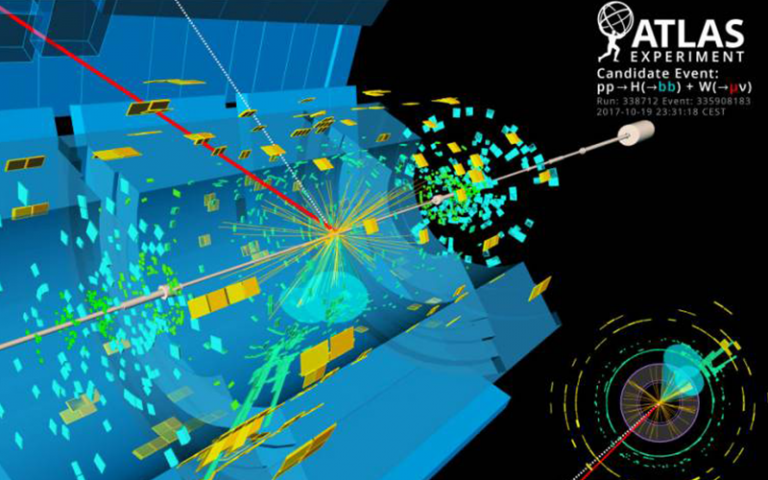Engaging international audiences through the discovery of the Higgs boson
UCL researchers who participated in the discovery of the Higgs boson have reached huge audiences worldwide and continue to improve public understanding of scientific research.

12 April 2022
The ATLAS detector, one of two general-purpose particle detectors at the CERN Large Hadron Collider (LHC), aims to understand electroweak symmetry breaking and the origin of mass; in the Standard Model the Higgs boson is responsible for these phenomena. The LHC began physics operation in late 2009, and on 4 July 2012 the ATLAS collaboration announced the discovery of a new particle, since shown to be a Higgs boson and consistent with the Standard Model. As a result, the Nobel Prize in Physics was awarded to the theorists Englert and Higgs in 2013.
A vital part of the story
The High Energy Physics (HEP) group, part of UCL’s Department of Physics & Astronomy, played a major role in the discovery of the Higgs boson. As well as analysing the data, HEP researchers were involved in constructing the ATLAS detector. They built electronics for the data acquisition and trigger systems; wrote simulation, trigger and visualisation code for the experiment; and worked on the mechanical engineering of the Semiconductor Tracker, including cable layout and thermal properties.
The public reaction to the discovery of the Higgs boson showed there is a clear appetite for accessible information about cutting-edge physics, which helps inform and raise the quality of public discourse around science and research in general. UCL contributions to the physics programme of the CERN Large Hadron Collider and related public engagement activities have both met and further stimulated this appetite.
Making physics accessible to the masses
Professor Jonathan Butterworth’s (UCL Department of Physics and Astronomy) "Life & Physics" blog began as a record of the research behind the Higgs boson discovery to present science and discoveries in a more accessible way.
The blog was hosted by The Guardian website between August 2010 and August 2018. Life & Physics posts have been published approximately weekly, attracting 3.7 million unique visitors (with peaks of approximately 20,000 per day) from many countries, including the UK, USA, Germany, France, and Australia.
Professor Butterworth’s other public engagements with broadcast media in response to public interest included television and radio appearances. Each episode of the BBC4 show “Infinite Monkey Cage” featuring Professor Butterworth gathered approximately two million listeners and 400,000 podcast downloads.
Professor Butterworth wrote two books - Smashing Physics (2015) and A Map of the Invisible (2018) - that provided a systematic explanation of his research in particle physics to the public in an accessible way.
Smashing Physics and A Map of The Invisible have been published in the UK, the US, China, Germany, Taiwan, France, Italy and Russia, with more than 36,800 copies and 22,000 copies respectively sold. The Royal Society acknowledged Smashing Physics for making “the most advanced science around seem within our grasp” and shortlisted it for the Winton Prize.
Engaging the next generation of physics students
Members of the UCL High Energy Physics group, including Professor Butterworth and his team, delivered at least 20 ATLAS-related school talks since January 2015, reaching approximately 1,200 Year 9-13 students in total. Such engagement effort has contributed to an 66% upsurge of applications to UCL undergraduate Physics courses from the schools that Professor Butterworth and his team have given talks to between 2012/2013 and 2019/2020.
Research synopsis
Improving public knowledge and understanding of particle physics with the discovery of the Higgs boson and other results from the ATLAS experiment at the CERN Large Hadron Collider
UCL physics researchers who participated in the discovery of the Higgs boson and the ATLAS experiment have contributed to media features, written articles, blog posts, public and school talks, panel discussions, and published books on the topic. These efforts have reached huge audiences worldwide and have continued to spark interest in physics and improve public understanding of the nature and purpose of scientific research.
Links
- Professor Jonathan Butterworth’s academic profile
- CERN Large Hadron Collider
- ATLAS experiment
- UCL High Energy Physics group
- Department of Physics and Astronomy
- UCL Faculty of Maths & Physical Sciences
- UCL Faculty of Maths & Physical Sciences REF 2021
Image credit
- ATLAS Collaboration/CERN : A candidate event display for the production of a Higgs boson decaying to two b-quarks (blue cones), in association with a W boson decaying to a muon (red) and a neutrino. The neutrino leaves the detector unseen, and is reconstructed through the missing transverse energy (dashed line)
 Close
Close

